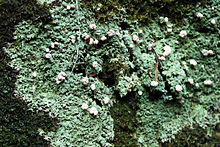
A lichen is a composite organism that arises from algae or cyanobacteria living among filaments of multiple fungi species in a mutualistic relationship. Lichens have properties different from those of their component organisms. They come in many colors, sizes, and forms and are sometimes plant-like, but are not plants. They may have tiny, leafless branches (fruticose); flat leaf-like structures (foliose); grow crust-like, adhering tightly to a surface (substrate) like a thick coat of paint (crustose); have a powder-like appearance (leprose); or other growth forms.
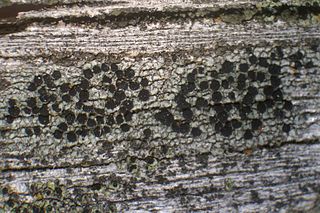
Buellia is a genus of mostly lichen-forming fungi in the family Caliciaceae. The fungi are usually part of a crustose lichen. In this case, the lichen species is given the same name as the fungus. But members may also grow as parasites on lichens (lichenicolous). The algae in the lichen is always a member of the genus Trebouxia.
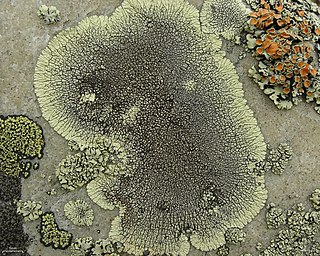
Dimelaena is a genus of rimose to areolate placoidioid crustose lichens. It is in the family Caliciaceae. Members of the genus are commonly called mountain lichens, or moonglow lichens. The genus has a widespread distribution and contains eight species.

Cyphelium is a genus of crustose areolate lichens with cup-like apothecia filled with sooty black spores. The genus is in the family Caliciaceae. The genus has a widespread distribution, especially in north and south temperate regions, and contains about 12 species. Members of the genus are commonly called soot lichens.
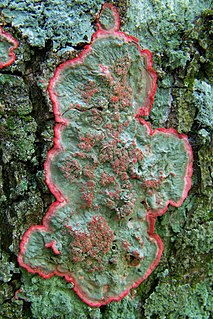
Cryptothecia is a genus of white to greenish crustose lichens that grow on bark, wood, or leaves. in tropical or subtropical areas worldwide. It has a conspicuous prothallus that develops around its periphery which can be bright red in some species, hence the common name wreath lichen. The main vegetative body (thallus) lacks a cortex (ecorticate and is often immersed in the substrate or byssoid. The medulla is white, well defined, and often peppered with calcium oxalate crystals. Ascomata are not well defined, being cushions of soft white mycelium immersed in the medullary tissue, hence the name from the Greek krypto = "to conceal" and theke = "a container or sheath". There are about 45 described species in the genus according to one source, and 75 species according to another. The genus is in the family Arthoniaceae. It contains Trentepohlia, a green alga, as its photobiont partner.
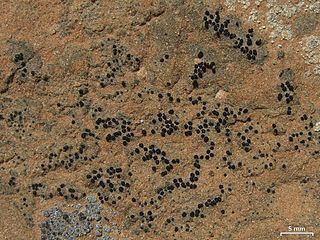
Staurothele is a genus of saxicolous (rock-dwelling), crustose lichens in the family Verrucariaceae. It has about 40 species. When the fungus is part of a lichen, the genus of lichen is commonly called rock pimples.
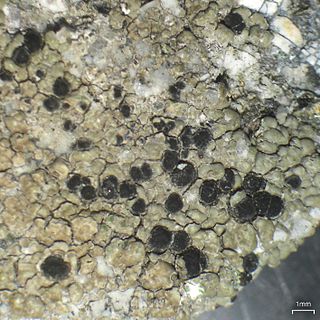
Lecidea is a genus of crustose lichens with a carbon black ring or outer margin (exciple) around the fruiting body disc (apothecium), usually found growing on (saxicolous) or in (endolithic) rock. Lichens that have such a black exciple are called lecideine, meaning "like Lecidea, even if they are not in this genus. Members of the genus are commonly called disk lichens or tile lichens.

Nodobryoria is a genus of medium to large, reddish-brown lichens that are hair-like to shrubby in shape and grow on conifer trees. The genus contains three species, distributed in North America and Greenland, which were previously included in the genus Bryoria. Nodobryoria is similar in appearance to Bryoria, but is differentiated because it does not contain the polysaccharide lichenin, and it has a unique cortex composed of interlocking cells that look like pieces of a jigsaw puzzle when viewed under a light microscope.
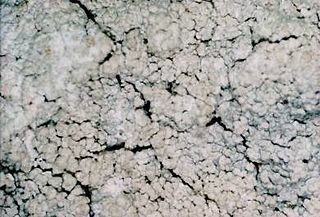
Lepraria is a genus of leprose crustose lichens that grows on its substrate like patches of granular, caked up, mealy dust grains. Members of the genus are commonly called dust lichens. The main vegetative body (thallus) is made of patches of soredia. There are no known mechanisms for sexual reproduction, yet members of the genus continue to speciate. Some species can form marginal lobes and appear squamulose. Because of the morphological simplicity of the thallus and the absence of sexual structures, the composition of lichen products are important characters to distinguish between similar species in Lepraria.

Pertusaria is a large genus of warty crustose lichens in the Pertusariaceae family. The fruiting bodies are usually modified apothecia that immersed in warts on the main body (thallus) with small holes for the spores to emerge, similar to ostioles, or are fully above and lecanorine (spore bearing discs surrounded by a ring of tissue similar to the tissue of the thallus. Members of the genus are commonly called wart lichens.

Mycoblastus is a genus of crustose lichens in the family Tephromelataceae. Members of the genus are commonly called blood lichens.

Lobothallia is a genus of lichens in the family Megasporaceae. Species in the genus have foliose thalli that become crustose areolate in the center with age, and grow on calcareous to siliceous rocks. The crustose part of the body may keep its lower cortex, though not always. Dark brown to black apothecia may be sunken into the surface of the thallus, as indicated in the common name puffed sunken disk lichen. Members grow to 3–5 cm (1.2–2.0 in) or more radiating lobes (placoidioid). The photobiont is green alga from the genus Trebouxia. The genus is represented in Eurasia, Asia, North Africa, Central America, western North America, and Australia.
Aspicilia californica is a small white to white mottled gray or gray-green foliose lichen, with stringy, terete, branch-like lobes. It is endemic to central and southern California, that grows on organic debris, moss, and rock in chaparral habitats. It attaches to the substrate at several points along the branch-like lobes. It may form areoles when growing on more solid substrates. Apothecia are rare. Lichen spot tests on the cortex and medulla are K+ red, KC-, C-, + orange, and I-. The olive brown Aspicilia filiformis is another fruticose species in this mostly crustose genus, occurring in Oregon, Idaho, Utah, Washington and Montana, with one known location also in California.
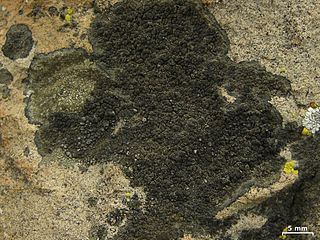
Buellia badia, the parasitic button lichen, is a dark chocolate-brown crustose areolate lichen of Europe, northern Africa, and North America that starts as a parasite growing on other lichens, such as Aspicilia phaea, gradually then becoming independent growing on rock (sometimes also on hardwood. Areoles may be contiguous or dispersed. Lecideine apothecia are 0.3 to 0.9 mm in diameter with black discs, that are initially flat, then become strongly convex as they age. Lichen spot tests are all negative. There are no known secondary metabolites as of. It is similar in appearance and other ways to the chocolate brown Dimelaena californica, which also starts off as a parasite on other lichens, and has spores of similar shape, size, and internal construction. D. californica has not been found on wood, is more preferential as to the lichens it starts growing on, and commonly has norstictic acid as a secondary metabolite. Some think they should be included in a new, third genus.

Protoparmelia badia is a species of crustose lichen in the family Parmeliaceae. It is a widely distributed, common species that grows on rocks.

Ochrolechia africana, commonly known as the frosty saucer lichen, is a species of crustose and corticolous (bark-dwelling) lichen in the family Ochrolechiaceae. It is a widely distributed species, found in tropical and subtropical areas of southern Africa, Asia, Australia, North America, and South America. The lichen is characterized by the presence of a white "frosty" or powdery apothecia.

The following outline provides an overview of and topical guide to lichens.

Ochrolechia upsaliensis is a species of crustose lichen in the family Ochrolechiaceae. Found in the Northern Hemisphere, it is commonly known as the tundra saucer lichen.
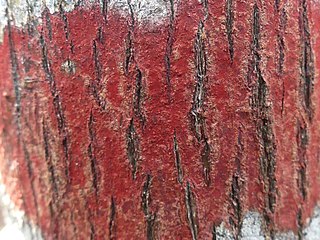
Pyrenula cruentata is a species of corticolous (bark-dwelling), crustose lichen in the family Pyrenulaceae. The lichen, characterized by its crimson-colored thallus and perithecial warts, has a neotropical distribution.
